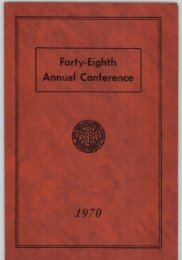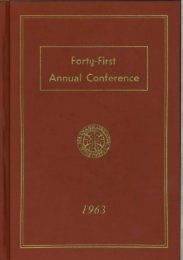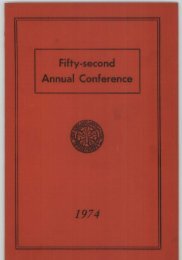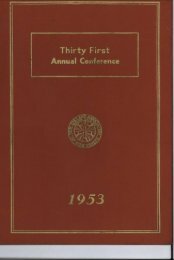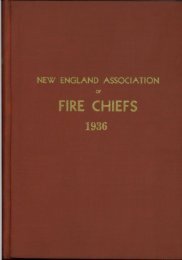NEAFC 32nd Annual Conference.pdf - New England Association of ...
NEAFC 32nd Annual Conference.pdf - New England Association of ...
NEAFC 32nd Annual Conference.pdf - New England Association of ...
You also want an ePaper? Increase the reach of your titles
YUMPU automatically turns print PDFs into web optimized ePapers that Google loves.
NEW ENGLAND ASSOCIATION OF FIRE CHIEFS<br />
before the A-Bombs were dropped, this ]?act had been demonstrated by<br />
the British Royal Air Force, which had burned the central areas o£ most<br />
o£ the ’German cities. Before the United States Army Air Forces dropped<br />
the A-Bombs, they had burned 67 Japanese cities. Even persons who<br />
knew these facts chose to ignore them."<br />
The atomic bomb and the new hydrogen bombs are huge, incendiary devices,<br />
among other things. They will start fires, from the immediate thermal<br />
effect o£ the bomb, and by blasting disruption caused by knocking over stoves;.<br />
breaking gas’. lines, and so forth.<br />
While we hav~ had exaggerated accounts <strong>of</strong> the power <strong>of</strong> new weapons to<br />
cause death and destruction, the bare truth about these bombs, is. sobering,<br />
indeed. Let us discuss. ]~ora moment the blast effects.<br />
The atomic bombs dropped over Japan havebeen rated the equivalent<br />
<strong>of</strong> 20,000 tons <strong>of</strong> TNT. They are called 1 (x) bombs. Larger bombs are<br />
merely multiples <strong>of</strong> this figure. Thus, a 2 (X) bomb has. the equivalent <strong>of</strong><br />
40,000 tons; an 8 (X) bomb, the equivalent <strong>of</strong> 160,000 tons, and a 50(X)<br />
bomb, that o£ 1,000,000 tons. This is. also called a megaton bomb.<br />
President Eisenhower has stated, oIficially, that existing atomic bombs: are<br />
now 25 times larger than those exploded in Japan, and that hydrogen bombs,<br />
which we have been hearing so much about, are in the megaton range.<br />
In so far as blast effects, are concerned, the radius <strong>of</strong> destruction resulting .<br />
from_ larger bombs does not increase in direct proportion to. the increase in size<br />
<strong>of</strong> the bomb. This distance increases approximately as’ the cube root <strong>of</strong> the<br />
ratio o£ the larger to the smaller bomb. Thus, if the bomb dropped was 1,000<br />
times more powerful than the one at Hiroshima, the radius <strong>of</strong> destruction<br />
would be the cube root <strong>of</strong> a thousand or ten times the radius, <strong>of</strong> destruction<br />
which occurred at Hiroshima.<br />
Great destructive bombs like the atomic and the hydrogen bomb are the<br />
particular enemies <strong>of</strong> large concentrations <strong>of</strong> industry and population. We<br />
dan assume that the size <strong>of</strong> the weapon an enemy chooses to aim at a certain<br />
target will be governed by the size <strong>of</strong> the target. That, <strong>of</strong> necessity, would<br />
eliminate, ]?or planning purposes anyway, the delivery Of these terrific weapons<br />
on small communities, or cross roads village.<br />
I suggest that for planning purposes the target areas, themselves select a<br />
size bomb which will include between one-half and all <strong>of</strong> the built-up s urban<br />
complex, in the zones <strong>of</strong> A, B, and C class damage. I suggest that two-thirds<br />
<strong>of</strong> the built-up area is a practical working figure on which to hang your hats.<br />
In an effort to destroy vital facilities more than one bomb might be used,<br />
particularly on cities that are spread out over large areas.<br />
As {or the small communities, they should in no way ~eel safe because<br />
the use o]? such big bombs, would be wasteful, if aimed at them. You, <strong>of</strong> the<br />
Fire Services, know more than any other, people how easy it is to set a destructive<br />
fir.e, and you know, also, what the effect <strong>of</strong> a few incendiaries might be.<br />
If you were not involved with fires yourselves, you must be prepared to help<br />
the communities that are.<br />
A complete organization <strong>of</strong> mutual aid assistance across, the country is<br />
imperative, if we are going to do the best job possible in controlling the fires<br />
that will result from enemy attack. . ..........<br />
183




